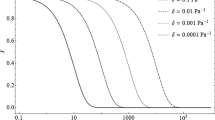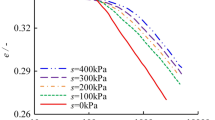Abstract
Geotechnical problems associated with unsaturated soils are common in semi-arid climates, where the upper soil layers are naturally unsaturated. Once a soil becomes unsaturated, its mechanical properties become different from its saturated counterpart. The main part of effective stress in unsaturated soils resulting from the soil moisture can be defined by the Suction Stress Characteristic Curve (SSCC). Although, the suction stress characteristic curve is determined from shear strength tests, but recent works show that the SSCC can be connected to the Soil Water Characteristic Curve (SWCC). This paper presents a simple and novel approach to model the effect of void ratio changes on SSCC in unsaturated soils. The proposed approach can be easily utilized with existing Soil Water Characteristic Curve (SWCC) equations to model any changes in suction stress for unsaturated soils. The main advantage of the suggested method is in fact its dependency to just one parameter, simply calibrated by the conventional water retention tests. This characteristic is so applicable in hydro mechanical constitutive models of unsaturated soils. Finally, the efficiently predicting of the experimental results implicitly demonstrates the applicability of effective stress principle using the concept of Suction Stress Characteristic Curve (SSCC) for unsaturated soils.
Similar content being viewed by others
References
Arya, L. M. and Paris, J. F. (1981). “A physicoempirical model to predict the soil moisture characteristic from particle-size distribution and bulk density data.” Soil Science Society of America Journal, Vol. 45, No. 6, pp. 1023–1030.
Assouline, S. (2001). “A model for soil relative hydraulic conductivity based on the water retention characteristic curve.” Water Resources Research, Vol. 37, No. 2, pp. 265–271.
Assouline, S. (2006). “Modelling the relationship between soil bulk density and the water retention curve.” Vadose Zone Journal, Vol. 5, No. 2, pp. 554–562.
Aubertin, M., Mbonimpa, M., Bussiere, B., and Chapuis, R. P. (2003). “A model to predict the water retention curve from basic geotechnical properties.” Canadian Geotechnical Journal, Vol. 40, No. 6, pp. 1104–1122.
Aubertin, M., Richard, J. F., and Chapuis, R. P. (1998). “A predictive model for the water retention curve: Application to tailings from hard-rock mines.” Canadian Geotechnical Journal, Vol. 35, No. 1, pp. 55–69.
Bishop, A. W., Blight, G. E. (1963). “Some aspects of effective stress in saturated and unsaturated soils.” Geotechnique, Vol. 13, No. 3, pp. 177–197.
Burger, C. A. and Shackelford, C. D. (2001a). “Evaluating dual porosity of pelletized diatomaceous earth using bimodal soil-water characteristic curve functions.” Canadian Geotechnical Journal, Vol. 38, No. 1, pp. 53–66.
Burger, C. A. and Shackelford, C. D. (2001b). “Soil-water characteristic curves and dual porosity of sand diatomaceous earth mixtures.” Journal of Geotechnical and Geoenviromental Engineering, Vol. 127, No. 9, pp. 790–800.
Fredlund, D. G., Xing, A., Fredlund, M. D., and Barbour, S. L. (1996). “Relationship of the unsaturated soil shear strength to the soil-water characteristic curve.” Canadian Geotechnical Journal, Vol. 33, No. 3, pp. 440–448.
Gallipoli, D., Wheeler, S.J., and Karstunen, M. (2003). “Modeling of variation of degree of saturation in a deformable unsaturated soil.” Geotechnique, Vol. 53, No. 1, pp. 105–112.
Haverkamp, R., Leij, F. J., Fuentes, C., Sciortino, A., and Ross, P. J. (2005). “Soil water retention: I. Introduction of a shape index.” Soil Science Society of America Journal, Vol. 69, No. 6, pp. 1881–1890.
Lee, S. J. (2004). Estimation of unsaturated shear strength and soil water characteristic curve for weathered soil, PhD Thesis, Department of Civil and Environmental Engineering, Korea Advanced Institute of Science and Technology, Daejeon, Korea.
Lee, S. J., Lee, S. R., and Kim, Y. S. (2003). “An approach to estimate unsaturated shear strength using an artificial neural network and hyperbolic formulation.” Computers and Geotechnics, Vol. 30, No. 6, pp. 489–503.
Li, X. S. (2005). “Modeling of hysteresis response for arbitrary wetting/drying paths.” Computers and Geotechnics, Vol. 32, No. 2, pp. 133–137.
Loret, B. and Khalili, N. (2000). “A three-phase model for unsaturated soils.” International Journal for Numerical and Analytical Methods in Geomechanics, Vol. 24, No. 11, pp. 893–927.
Lu, N., Godt, J., and Wu, D. T. (2010). “A closed-form equation for effective stress in unsaturated soil.” Water Resources Research, Vol. 46, No. 5, pp. 1–14.
Lu, N. and Likos, W. J. (2004). Unsaturated soil mechanics, John Wiley & Sons Inc., New York.
Lu, N. and Likos, W. J. (2006). “Suction stress characteristic curve for unsaturated soils.” Journal of Geotechnical and Geoenvironmental Engineering, Vol. 132, No. 2, pp. 131–142.
Masin, D. (2010). “Predicting the dependency of a degree of saturation on void ratio and suction using effective stress principle for unsaturated soils.” International Journal for Numerical and Analytical Methods in Geomechanics, Vol. 34, No. 1, pp. 73–90.
Mbonimpa, M., Aubertin, M., Maqsoud, A., and Bussiere, B. (2006). “A predictive model for the water retention curve of deformable clayey soils.” ASCE Journal of Geotechnical and Geoenvironmental Engineering, Vol. 132, No. 9, pp. 1121–1132.
Mualem, Y. (1976). “A new model for predicting the hydraulic conductivity of unsaturated porous media.” Water Resources Research, Vol. 12, No. 3, pp. 513–522.
Ng, C. W. W., Cui, Y. J., Chen, R., and Delage, P. (2007). “The axistranslation and osmotic techniques in shear testing of unsaturated soils.” Soils and Foundations, Vol. 47, No. 4, pp. 675–84.
Nuth, M. and Laloui, L. (2008). “Effective stress concept in unsaturated soils: Clarification and validation of a unified framework.” International Journal for Numerical and Analytical Methods in Geomechanics, Vol. 32, No. 7, pp. 771–801.
Sun, D. A., Sheng, D., Xiang, Li., and Sloan, S. W. (2008). “Elastoplastic prediction of hydro-mechanical behavior of unsaturated soils under undrianed conditions.” Computers and Geotechnics, Vol. 35, No. 6, pp. 845–852.
Sun, D. A., Sheng, D., and Xu, Y. F. (2007). “Collapse behavior of unsaturated compacted soil with different initial densities.” Canadian Geotechnical Journal, Vol. 44, No. 6, pp. 673–686.
Sun, D. A., Sun, W., and Xiang, L. (2010). “Effect of degree of saturation on mechanical behaviour of unsaturated soils and its elastoplastic simulation.” Computers and Geotechnics, Vol. 37, No. 5, pp. 678–88.
Tamagnini, R. (2004). “An extended Cam-Clay model for unsaturated soils with hydraulic hysteresis.” Geotechnique, Vol. 54, No. 3, pp. 223–228.
Tarantino, A. (2009). “A water retention model for deformable soils.” Geotechnique, Vol. 59, No. 9, pp. 751–762.
Van Genuchten, M. T. (1980). “A closed-form equation for predicting the hydraulic conductivity of unsaturated soils.” Soil Science Society of America Journal, Vol. 44, No. 5, pp. 892–898.
Vanapalli, S. K., Fredlund, D. E., Pufahl, D. E. and Clifton, A. W. (1996). “Model for the prediction of shear strength with respect to soil suction.” Canadian Geotechnical Journal, Vol. 33, No. 3, pp. 379–392.
Vanapalli, S. K., Fredlund, D.G., and Pufahl, D. E. (1999). “The influence of soil structure and stress history on soil-water characteristics of a compacted till.” Geotechnique, Vol. 49, No. 2, pp. 143–159.
Wang, Y., Wu, G., Grove, S. M., and Anderson, M. G. (2008). “Modeling water retention characteristic of unsaturated soils.” Unsaturated soils: Advances in Geoengineering, First European Conference on Unsaturated Soils, Durham, UK, pp. 675–681.
Wheeler, S. J. (1996). “Inclusion of specific water volume within an elastoplastic model for unsaturated soil.” Canadian Geotechnical Journal, Vol. 33, No. 1, pp. 42–57.
Wheeler, S. J., Näätänen, A., Karstunen, M., and Lojander, M. (2003). “An anisotropic elastoplastic model for soft clays.” Canadian Geotechnical Journal, Vol. 40, No. 2, pp. 403–418.
Zhang, L. M. and Chen, Q. (2005). “Predicting bimodal soil-water characteristic curves.” Journal of Geotechnical and Geoenviromental Engineering, Vol. 131, No. 5, pp. 666–670.
Author information
Authors and Affiliations
Corresponding author
Rights and permissions
About this article
Cite this article
Heshmati, A.A., Motahari, M.R. Modeling the dependency of Suction Stress Characteristic Curve on void ratio in unsaturated soils. KSCE J Civ Eng 19, 91–97 (2015). https://doi.org/10.1007/s12205-013-1185-0
Received:
Revised:
Accepted:
Published:
Issue Date:
DOI: https://doi.org/10.1007/s12205-013-1185-0




